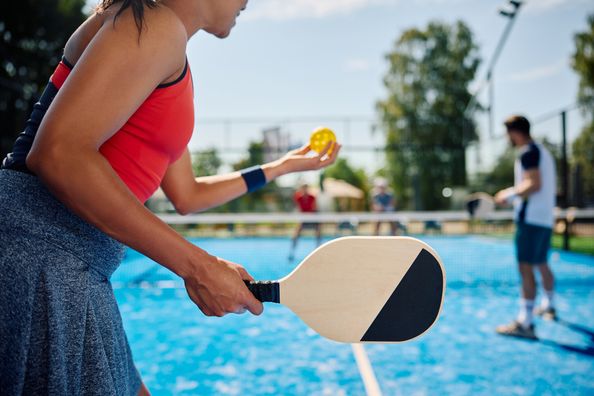If you’re a pickleball enthusiast, you know that this quirky and fast-paced sport is taking the world by storm. With a mix of tennis, badminton, and ping pong, pickleball provides an exciting and competitive experience for players of all ages and skill levels. Despite the laughter and friendly competition, there’s one thing that can put a damper on your pickleball fun: injuries. Yes, the pickleball court can be a battlefield of sprained ankles, strained muscles, and more. In fact, our Orthopaedic team has seen an increase in injuries caused by this fast-growing activity.
Stay in the game by understanding the top five common pickleball injuries and tips on how to keep your pickleball game strong.
“Oh, My Ankle!” – Sprained Ankles
The lateral movements and quick direction changes in pickleball can put stress on your ankles, making sprained ankles a common occurrence on the court. This can occur by landing awkwardly, stepping on a ball, or twisting your ankle during a fast-paced game.
Treatment for Sprained Ankles
R.I.C.E, which stands for Rest, Ice, Compression and Elevation, is the key to managing a sprained ankle. Start by taking a break from the court and allowing your ankle to rest, followed by applying ice to reduce swelling, wrapping it with a compression bandage and elevating the foot. Over-the-counter medications can also be helpful to manage pain and inflammation.
It is also important to start gentle range of motion exercises early in the process and bear weight as you tolerate. If you are unable to bear weight, it is a good idea to be seen by one of our providers and get an X‑ray to ensure that a more serious injury, such as a fracture, has not occurred. And remember, always wear supportive and well-fitted shoes to provide stability to your ankles during pickleball games.
“Ouch, My Shoulder!” – Rotator Cuff Strains
The overhead swings and repetitive shoulder movements in pickleball can stress the rotator cuff, leading to pain and discomfort. Overuse, poor technique and lack of warm-up can increase the risk of this injury.
Treatment for Rotator Cuff Strains
If you experience shoulder pain, it’s important to rest and avoid repetitive overhead activity. Ice, gentle motion and strengthening exercises can help reduce discomfort. Physical therapy may also be recommended for more severe or lingering cases.
A proper warm up, including light cardiovascular and range of motion exercises, in addition to proper technique, can reduce the risk of rotator cuff injury. If the pain lingers for several weeks or you are having difficulty lifting your arm away from your body, come in for evaluation.
Dealing with a nagging injury that’s keeping you off the court? Our orthopaedic team can help you recover and get back to the game you love. If you need a same-day appointment, schedule with one of Duly’s Ortho Now providers.
Find Duly Ortho Now clinics near you >
“Yikes, My Knee!” – Patellar Tendinitis
The repetitive jumping and squatting motions in pickleball can strain the patellar tendon, causing patellar tendinitis, commonly known as “jumper’s knee.” This can result in pain and swelling around the knee, making it difficult to move around the court.
Treatment for Patellar Tendinitis
Rest is crucial to allow the inflamed tendon to heal. Applying ice, gentle stretching and strengthening exercises can also help relieve the pain. Wearing knee sleeves or using patellar straps can provide additional support and reduce strain on the tendon.
Return to play slowly, gradually increasing the frequency, intensity and duration of each session over several weeks. Perhaps the most important part of managing patellar tendinitis is an appropriate warm up before the game starts.
“Ouch, My Back!” – Lower Back Strains
The repetitive twisting, bending and reaching motions in pickleball can stress the muscles and ligaments of the lower back, leading to lower back pain. Poor posture, lack of core stability and sudden movements can increase the risk of back injuries on the court.
Treatment for Lower Back Strains
Rest, ice and over-the-counter pain medication can help alleviate acute back pain. Gentle stretching, strengthening exercises and practicing good posture can also promote healing and prevent future injuries. It’s important to engage your core muscles and maintain a neutral spine position during pickleball games to reduce the risk of injury.
It is imperative to continue gentle motion through the spine during treatment even if this causes some mild discomfort. Referred pain into the legs, numbness or tingling are all reasons to seek medical attention.
Just like any physical activity, pickleball comes with the risk of injuries. Sprained ankles, rotator cuff strains, patellar tendinitis and lower back strains are some of the common pickleball injuries that players may encounter.
By following some simple tips and taking precautions, you can keep your pickleball game strong and minimize the risk of injuries. Remember to wear supportive shoes, warm up and cool down properly, practice good technique and listen to your body.
If you overdo it in your next pickleball match, our orthopaedic team will help get you off the sidelines and back in the game safely. Schedule a same-day appointment with a Duly Ortho Now provider today.
Find Duly Ortho Now clinics near you >
Health Topics:








